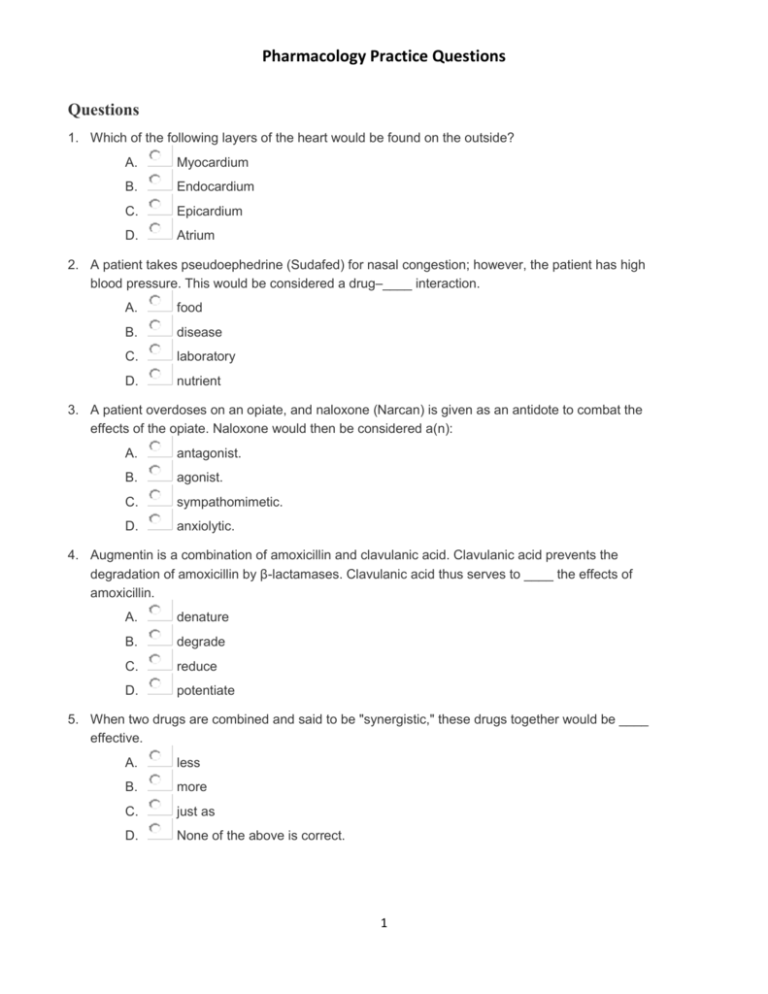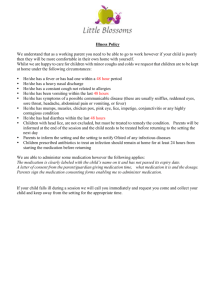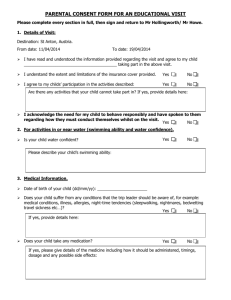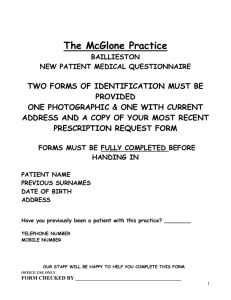File - Pharmacy Technician Toolkit
advertisement

Pharmacology Practice Questions Questions 1. Which of the following layers of the heart would be found on the outside? A. Myocardium B. Endocardium C. Epicardium D. Atrium 2. A patient takes pseudoephedrine (Sudafed) for nasal congestion; however, the patient has high blood pressure. This would be considered a drug–____ interaction. A. food B. disease C. laboratory D. nutrient 3. A patient overdoses on an opiate, and naloxone (Narcan) is given as an antidote to combat the effects of the opiate. Naloxone would then be considered a(n): A. antagonist. B. agonist. C. sympathomimetic. D. anxiolytic. 4. Augmentin is a combination of amoxicillin and clavulanic acid. Clavulanic acid prevents the degradation of amoxicillin by β-lactamases. Clavulanic acid thus serves to ____ the effects of amoxicillin. A. denature B. degrade C. reduce D. potentiate 5. When two drugs are combined and said to be "synergistic," these drugs together would be ____ effective. A. less B. more C. just as D. None of the above is correct. 1 Pharmacology Practice Questions 6. In which pregnancy category have animal or human studies shown fetal abnormalities or toxicity and the risk outweighs the benefits? A. A B. B C. C D. X 7. Which of the following is the best definition for a brand name? A. Assigned by the drug manufacturer and is protected through a patent B. Determined by chemical structure of the drug entity C. D. Assigned to a medication and contains a word stem that has been issued by the U.S. Adopted Names Council Determined by the botanical origin of the drug entity 8. Which of the following is the best definition for a generic name? A. Assigned by the drug manufacturer and is protected through a patent B. Determined by chemical structure of the drug entity C. D. Assigned to a medication and contains a word stem that has been issued by the U.S. Adopted Names Council Determined by the botanical origin of the drug entity 9. Suffixes are often useful in determining the drug class of a medication. Which of the following suffixes is correctly matched to its drug class? A. -prazole: Proton pump inhibitor for acidic conditions B. -vastatin: H2-blocker for acidic conditions C. -pril: Cholesterol-lowering medication D. -tidine: ACE inhibitor 10. Ranitidine (Zantac) and loratadine (Claritin) have very similar suffixes, yet are very different in their pharmacologic function. What is the difference? A. Both are antihistamines, but one affects acid and the other allergies. B. Loratadine (Claritin) is for acidic conditions, and ranitidine (Zantac) is for allergic conditions. C. Ranitidine (Zantac) is nonsedating, but loratadine (Claritin) is very sedating. D. Both are antihistamines, and there is no difference in their effects. 2 Pharmacology Practice Questions 11. All of the following are ways a patient might distinguish the classes of the medications nystatin (Mycostatin) and atorvastatin (Lipitor) except which of the following? A. B. Both have the ending –statin. The ending that indicates cholesterol lowering is -vastatin, to which nystatin does not conform. C. Myco- is a prefix that means fungus. D. Lipi- is one letter short of lipid, and cholesterol is a type of lipid. 12. Which of the following drug interactions is correctly matched to its definition? A. Addition: The combined effect of two drugs; it is equal to the sum of the effects of each drug taken alone B. Antagonism: The joint action of drugs in which their combined effect is more intense or longer in duration than the sum of the effects of two drugs C. D. Potentiation: One drug works against the action of another drug Synergism: One drug increases or prolongs the effect of another drug; the total effect is greater than the sum of the effects of each drug alone 13. Prefixes are often useful in determining the drug class of a medication. Which of the following prefixes is correctly matched to its drug class? A. sulfa-: Sulfonamide antibiotic B. ceph- or cef-: Estrogen C. estr-: Cephalosporin antibiotic D. profen-: Antiinflammatory 14. Which of the following mechanisms of action is correctly matched to its antibiotic class? A. Penicillins prevent bacteria from forming a cell wall. B. Sulfonamides inhibit protein synthesis in bacteria by binding ribosomes. C. Cephalosporins interfere with folic acid formation. D. Tetracyclines prevent bacteria from forming a cell wall. 15. Which of the following mechanisms of action is correctly matched to its antibiotic class? A. Penicillins inhibit protein synthesis in bacteria by binding ribosomes. B. Macrolides inhibit protein synthesis by interacting with ribosomes. C. Cephalosporins interfere with folic acid formation. D. Tetracyclines prevent bacteria from forming a cell wall. 3 Pharmacology Practice Questions 16. Sulfonamides have the ability to block folic acid synthesis in bacteria, but humans also need folic acid for proper functioning. Why does a sulfonamide harm only the bacteria and not a human? A. Bacteria must manufacture their own folic acid; humans can ingest it. B. Bacteria are dependent on folic acid; humans are not. C. Humans are dependent on folic acid; bacteria are not. D. Folic acid is only necessary in pregnant women. 17. In looking at erythromycin and azithromycin, two macrolides, what improvement does azithromycin have in terms of patient compliance? A. It comes in a suspension. B. It has once-daily dosing. C. It comes in a solid dosage form. D. Azithromycin has no advantage over erythromycin. 18. A physician orders a quinolone antibiotic. The generic name of the medication would most likely end in: A. -floxacin. B. -cillin. C. -mycin. D. -cycline. 19. A patient is being changed from a quinolone antibiotic to a macrolide antibiotic. What will the suffix of the new medication likely be? A. -floxacin B. -cillin C. -mycin D. -cycline 20. A patient is cautioned that the medication she was prescribed might cause nephrotoxicity, ototoxicity, tinnitus, and even permanent deafness. What class of antibiotic was this patient likely prescribed? A. Aminoglycoside B. Quinolone C. Penicillin D. Tetracycline 4 Pharmacology Practice Questions 21. A patient takes an antibiotic medication and exhibits a cross-sensitivity to his previous penicillin allergy. What nonpenicillin class of antibiotics was the patient likely given? A. Sulfonamide B. Macrolide C. Tetracycline D. Cephalosporin 22. A patient is diagnosed with a fungal infection. Which medication could not be prescribed for this indication? A. Amphotericin B. Nystatin C. Fluconazole D. Levofloxacin 23. A patient is diagnosed with a viral infection. Which medication could not be prescribed for this indication? A. Tetracycline B. Acyclovir C. Famciclovir D. Oseltamivir 24. Which of the following is not a medication used in the treatment of the HIV retrovirus? A. Acyclovir B. Abacavir C. Didanosine D. Tenofovir 25. Which of the following is not a class of HIV medication therapy? A. Protease inhibitors B. Fusion inhibitors C. Antiprotozoals D. Non-nucleoside reverse transcriptase inhibitors (NNRTIs) 5 Pharmacology Practice Questions 26. HIV medications interfere with processes critical to the HIV virus. Which of the following drug classes would likely interfere with an enzyme? A. Fusion inhibitors B. Non-nucleoside reverse transcriptase inhibitors (NNRTIs) C. Protease inhibitors D. Both b and c 27. Often patients confuse the need for a decongestant with an antihistamine for their cold symptoms. Which of the following represents a decongestant? A. Diphenhydramine B. Pseudoephedrine C. Loratadine D. Azelastine 28. A patient comes into the pharmacy complaining of congestion and sneezing. Which of the following combination products would be appropriate for these symptoms? A. Cetirizine and pseudoephedrine B. Chlorpheniramine and hydrocodone C. Guaifenesin and codeine D. Promethazine and codeine 29. A patient has anxiety. Which medication would likely be prescribed for this condition? A. Alprazolam B. Diphenhydramine C. Codeine D. Levofloxacin 30. Which of the following medications is not an SSRI antidepressant? A. Paroxetine B. Alprazolam C. Sertraline D. Citalopram 6 Pharmacology Practice Questions Answer Key: 1. c 16. a 2. b 17. b 3. a 18. a 4. d 19. c 5. b 20. a 6. a 21. d 7. a 22. d 8. c 23. a 9. a 24. a 10. a 25. c 11. a 26. d 12. a 27. b 13. a 28. a 14. a 29. a 15. b 30.b Resources Mizner: Mosby's Review for the Pharmacy Technician Certification Examination, 3rd Edition 7




